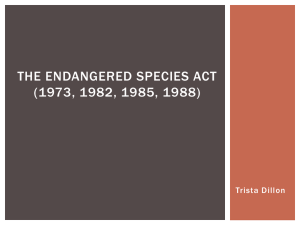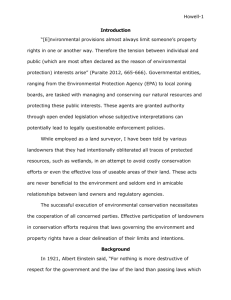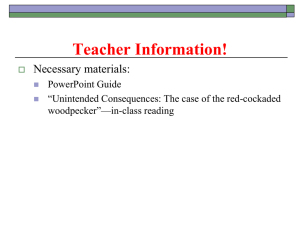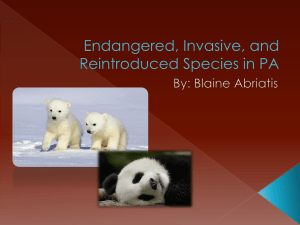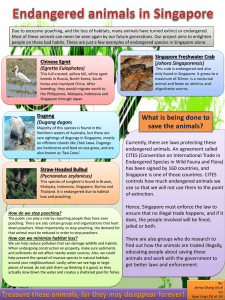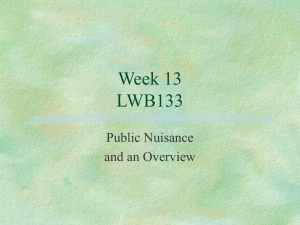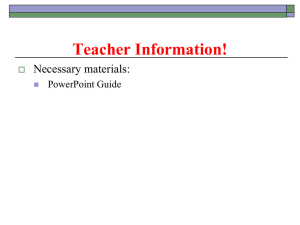LIMITING WIND FARM LIABILITY - Department of Agricultural
advertisement
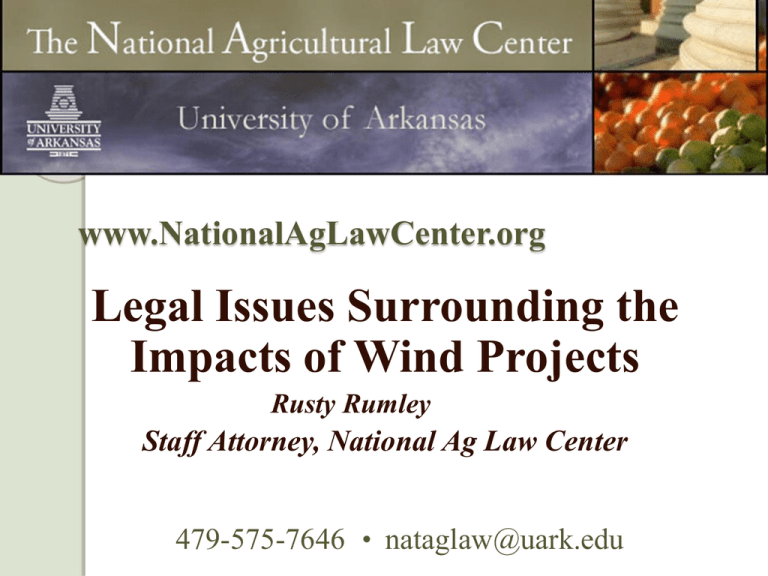
www.NationalAgLawCenter.org Legal Issues Surrounding the Impacts of Wind Projects Rusty Rumley Staff Attorney, National Ag Law Center 479-575-7646 • nataglaw@uark.edu The nation’s leading resource for agricultural and food law research and information Federally funded, non-partisan research and information center Research - Information - Education Administrative Law Animal Identification Aquaculture Biosecurity Business Orgs Clean Water Act Commercial Trans. Conservation Programs Cooperatives Disaster Asst/Crop Ins Estate & Taxation Food Labeling International Law Labor Landowner Liability Local Food Systems Nat’l Organic Program Packers & Stockyards Pesticides Renewable Energy Specialty Crops Urbanization & Ag Agritourism ADR AFOs Animal Welfare Bankruptcy Biotechnology Checkoff Climate Change Commodity Programs Corp. Farming COOL Environmental Law Finance & Credit Food Safety International Trade Marketing Orders Nutrition Programs PACA Production Contracts Secured Trans. Sustainable Ag Water Law • • • • • • • • Overview Major Statutes Regulations Case Law Index Center Research Publications Congressional Research Service Reports Agricultural Law Bibliography Reference Resources • • Governmental Agency Resources Congressional Resources International Resources Publications Additional Resources Outline Impacts to Landowners Nuisance claims against wind projects Other tort claims surrounding wind projects Environmental Impacts Endangered Species Act Impacts to Landowners There are many potential positive and negative impacts of wind projects to the surrounding landowners and community. Economic, environmental, legal, and so on… I’m going to be addressing some of the legal issues that can arise with landowners and environmental concerns Both those that signed a lease agreement and those that did not What is a Tort? A person is legally Everyone is responsible if their entitled to not be action injures injured and not to someone else or have their damages someone property damaged else’s property Tort: • A wrongful act or omission which injures another person's body, property, or reputation. • These have existed for hundreds of years and served as environmental laws long before anyone had thought about the environment Tort Claims Against Wind Projects Noise, Vibrations, “Shadow Flicker” Aesthetics (the scenery) Other Tort Concerns Ice Throw Blade Shear Fire Roaming livestock Nuisance Nuisance – a substantial and unreasonable interference with a person's enjoyment and use of their land 2 types: Public and Private This covers a wide range of actions such as Noise Odor Lights Dust Flies And so on… Nuisance Elements Fault - defendant intentionally, negligently, or recklessly interfered with plaintiff. Substantial and ongoing (not petty…) This one typically isn’t hard to show In some cases this can be hard to show, but this is not an issue with wind projects because of their long life Reasonableness (utility vs. harm) This element is the one that suits against wind projects have had trouble with… “Does the gravity of harm outweigh the social value of the activity that allegedly caused the harm” Noise, Vibrations & Shadow Flicker One of the more common claims brought against wind projects and typically more successful than other claims Reasonableness is still a big issue and it makes it incredibly fact specific. A certain level of noise may be a nuisance in OKC, but it may be “reasonable” in northern OK. How is that noise being generated? Nightclub v. construction project Other factors come into play: Improved engineering, such as reducing the thickness of the blades, has decrease the sound issue which may make it more “reasonable” Where is it located, what is the setback requirement, where is the nearest house, etc… SHADOW FLICKER Example Ted is a landowner that lives very near a wind project and he is suing the developer under nuisance because of the shadow flicker. What may happen? If Ted signed a lease or any contract then may very well have signed away any right to sue…read the contract carefully! If Ted did not sign the contract then you walk through the elements of nuisance. Is someone at fault? Is the problem substantial and ongoing? What is the reasonableness v. the harm? This is where Ted will have a difficult time… AESTHETIC NUISANCES These are brought claiming that the view has been detrimentally altered. Typically these claims are not very successful if brought by themselves because this is so subjective Remember the old saying, “Beauty is in the eye of the beholder” Other Causes of Action Trespass – a direct physical invasion of someone’s real property (land) This is the other side of nuisance. Something or someone has to actually enter on to your property. While this can include somebody coming on to your property without permission it can also include: Ice throw – this is ice freezing to the blade and then being thrown out once the turbine starts turning again Blade sheer – a blade breaking off What makes this unique is that there is no “reasonableness” standard…any trespass can give rise to a lawsuit even if there are no damages (but it helps to have damages) Other Causes of Action Negligence - The failure to act as an ordinary, reasonable, and prudent person under the same or similar circumstances. This is typically the catchall and many lawsuits in the US are brought under this This would cover things such as fires started by turbines or if the people maintaining the turbine left a gate open and cattle got out into the road. Like many of the other torts this one is very fact specific You can protect against this by contract in many cases Remedies If a tort action is successful then there is the question of “Where do you go from here?” Typically if someone is successful with a tort case then they can either recover damages ($$$) or ask for an injunction Many nuisance claims ask for an injunction which works like a cease and desist order However, because of the gross expenditure of capital, courts are less likely to enjoin a wind project which is either under construction or already producing energy Torts Summary If no contract has been signed then the general rules surrounding torts applies The ability to bring a lawsuit can be modified by a contract (i.e. a lease)…check your lease Depending upon the lease agreement, it may have a clause stating that you release them from any liability This right to bring a lawsuit can be contracted away even if no turbine was placed on your property It is a good idea to address concerns such as damage to property (ice throw, fire and cattle getting out) in the contract Environmental Impacts Today we are going to focus on the Endangered Species Act. There are other environmental laws out there that are important, but this be a problem for both the wind project and you as a landowner … Endangered Species Act How does this issue come up and why is it important to landowners as well? Before any large project begins that has some form of federal funding or tax incentives the developer must do an environmental impact statement (which is mandated by another environmental law) and part of that includes a very detailed study of all the animals and plants in the area If they find an endangered or threatened species then it is an issue for everybody…including you as a landowner Endangered Species Act Purpose: To “protect and recover imperiled species and the ecosystems upon which they depend.” How? Species may be listed as either endangered or threatened. “Endangered” means a species is in danger of extinction throughout all or a significant portion of its range. “Threatened” means a species is likely to become endangered within the foreseeable future. ESA: Who’s in Charge? U.S. Fish and Wildlife Service (FWS) has primary responsibility for terrestrial and freshwater organisms National Marine Fisheries Service (NMFS) is responsible for marine wildlife such as whales and anadromons fish such as salmon. Anadromons: “Fish ascending rivers from the sea for breeding” ESA: How are they listed? FWS considers five factors: damage to, or destruction of, a species’ habitat overutilization of the species for commercial, recreational, scientific, or educational purposes disease or predation inadequacy of existing protection; and other natural or manmade factors that affect the continued existence of the species. ESA: Consequences of “Listing” The “take” of listed animals is prohibited “to harass, harm, pursue, hunt, shoot, wound, kill, trap, capture, or collect or attempt to engage in any such conduct.” “Harm” is “an act which actually kills or injures wildlife.” Such an act may include significant habitat modification or degradation where it actually kills or injures wildlife by significantly impairing essential behavioral patterns, including breeding, feeding, or sheltering.” The interstate or international trade in listed plants and animals, including their parts and products is also prohibited Endangered Species Act This statute is one where landowners need to be careful because it is VERY easy to “take” an animal! Snail darters Black-tailed Prairie Dogs Fence lines In some ways the ESA can work almost like an easement against the landowner Bat Mortality Often this is the type of animal that is most affected by wind turbines (it is a bit of an issue with some birds however) Two Causes Collisions Barotrama Damage caused to enclosed air-containing cavities (lungs, eardrums, etc.) as a result of a rapid change in external pressure Animal Welfare Institute v. Beech Ridge Energy LLC Policy Analysis of the ESA of 1973 versus legislation promoting renewable energy Court held for the Animal Welfare Institute because of the severe effect on the Indiana bat population of West Virginia Part of the issue in this case was that the developer did not do a very thorough job of preparing the environmental impact statement…they went out and looked for endangered species in the summer, but did not think about migrating species. Endangered Species Act Summary The ESA is a powerful piece of environmental law If an endangered species is found in the area then the FWS has some extraordinary powers that they can use to protect that species This can closely resemble an easement on your property…they cannot make you take any affirmative actions to help the species, but they can stop you from making any changes to your property that might adversely affect the species Any Questions? Disclaimer The University of Arkansas National Agricultural Law Center does not provide legal advice. Any information provided on or by this Web site is not intended to be legal advice, nor is it intended to be a substitute for legal services from a competent professional. This work is supported by the U.S. Department of Agriculture under Agreement No. 59-8201-9-115, and any opinions, findings, conclusions, or recommendations expressed in the material on this Web site do not necessarily reflect the view of the U.S. Department of Agriculture. Web site: www.NationalAgLawCenter.org Phone: (479)575-7646 Email: NatAgLaw@uark.edu


